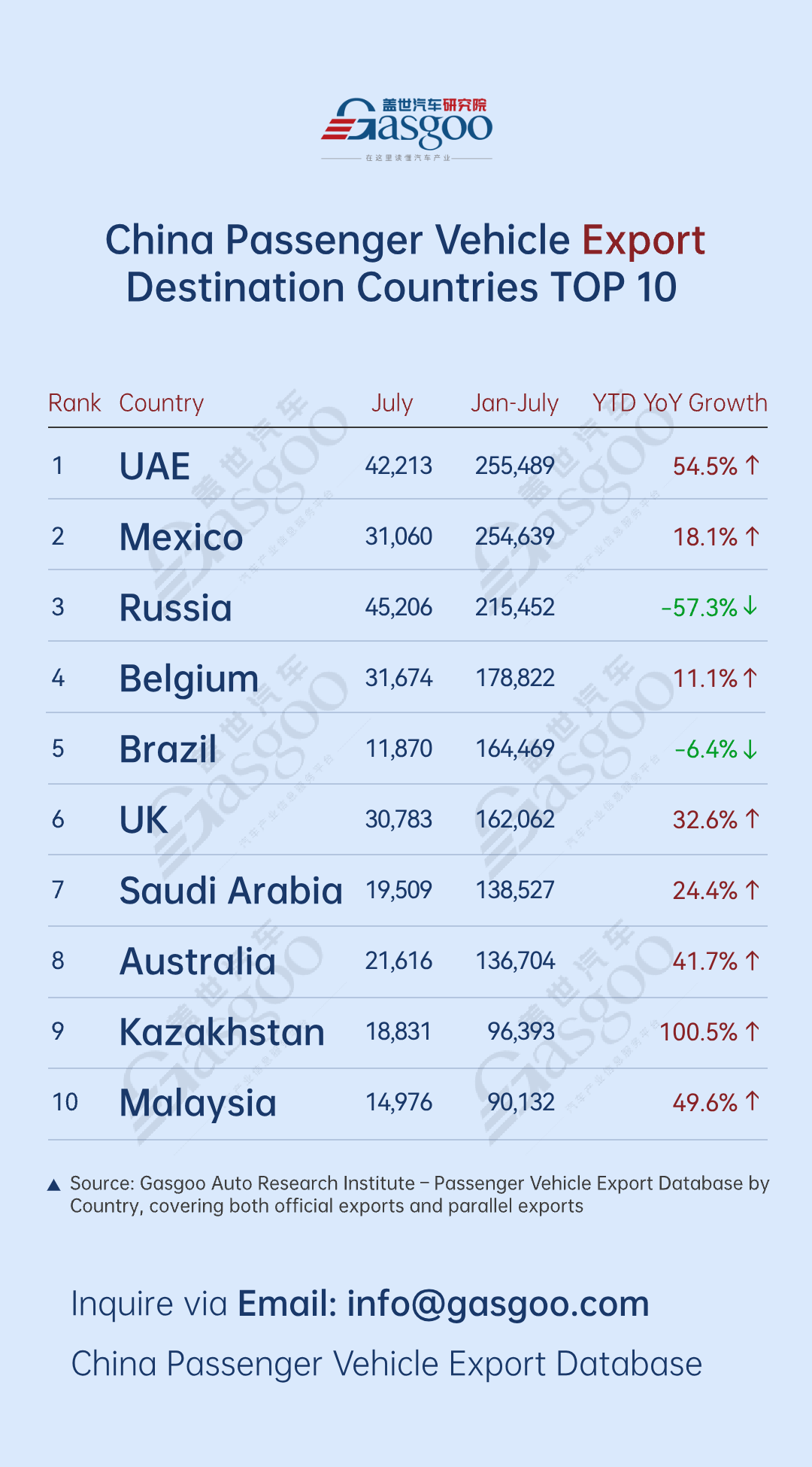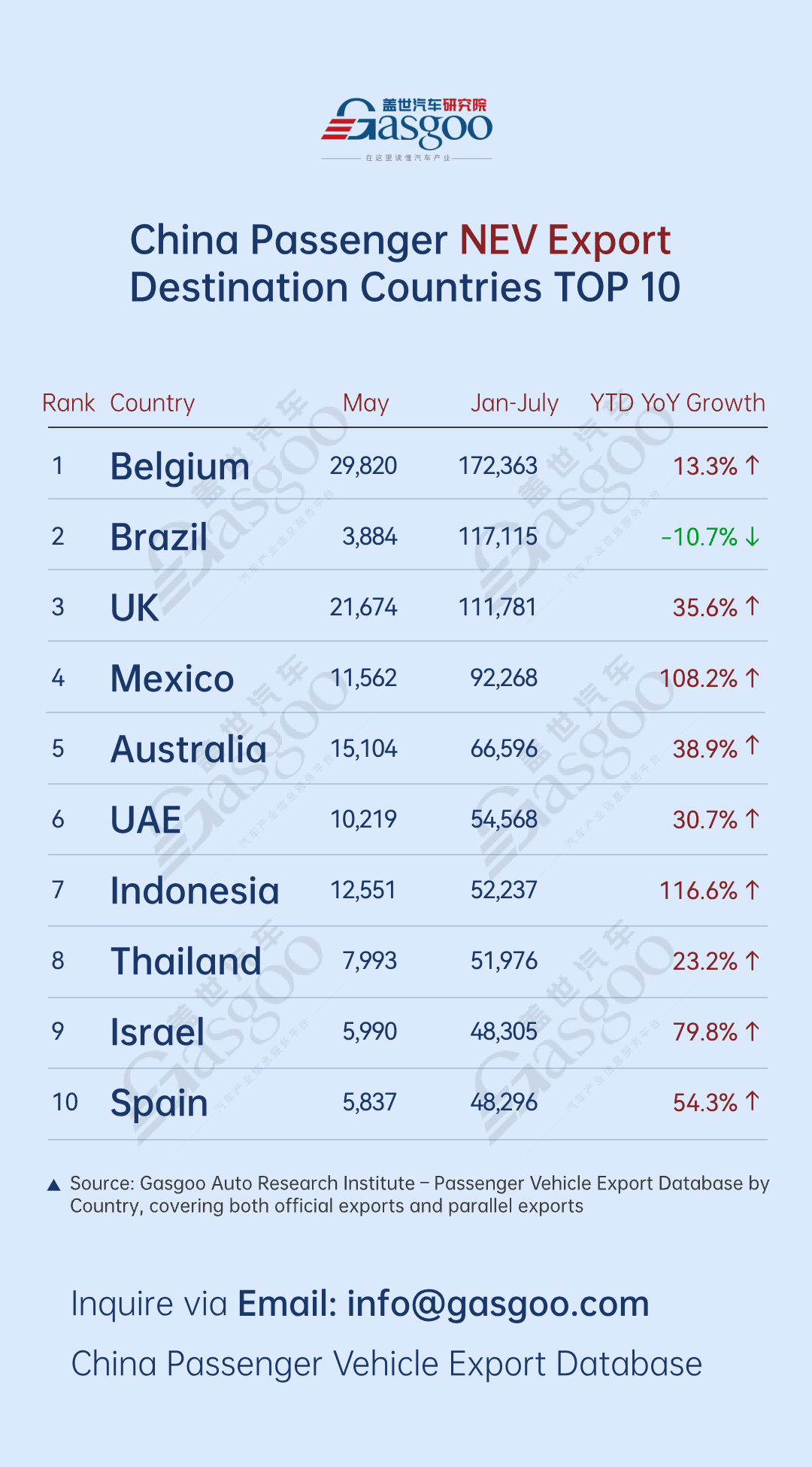UAE tops overall export markets; Mexico shows steady growth丨China’s passenger vehicle export overview (Jan.-Jul. 2025)
From January to July 2025, the landscape of China's passenger vehicle exports shifted, with the UAE taking the lead at 255,489 units, followed by Mexico and Russia. Notably, exports to the traditional stronghold of Russia fell sharply by 57.3% YoY, while emerging markets in the Middle East and Southeast Asia showed robust growth, with Kazakhstan registering a remarkable 100.5% YoY surge.
Top 10 destination countries by China's passenger vehicle exports
UAE: 42,213 units in July and 255,489 units (+54.5% YoY) from January to July
Mexico: 31,060 units in July and 254,639 units (+18.1% YoY) from January to July
Russia: 45,206 units in July and 215,452 units (-57.3% YoY) from January to July
Belgium: 31,674 units in July and 178,822 units (+11.1% YoY) from January to July
Brazil: 11,870 units in July and 164,469 units (-6.4% YoY) from January to July
UK: 30,783 units in July and 162,062 units (+32.6% YoY) from January to July
Saudi Arabia: 19,509 units in July and 138,527 units (+24.4% YoY) from January to July
Australia: 21,616 units in July and 136,704 units (+41.7% YoY) from January to July
Kazakhstan: 18,831 units in July and 96,393 units (+100.5% YoY) from January to July
Malaysia: 14,976 units in July and 90,132 units (+49.6% YoY) from January to July

In July, the UAE, Mexico, and Russia remained the top 3 destinations for Chinese passenger vehicle exports. The UAE led the ranking with a cumulative 255,489 units and a robust 54.5% YoY growth, recording 42,213 units in July alone. This monthly performance allowed the UAE to surpass Mexico by nearly 1,000 units, becoming the largest export market.
Mexico ranked second with a cumulative 254,639 units in the Jan.-Jul. perido, representing an 18.1% YoY increase. According to Gasgoo, the Mexican government plans to raise tariffs on Chinese imports, including automobiles, textiles, and plastics, as part of its 2026 budget proposal to be submitted next month.
Although Russia led in July with 45,206 units exported, its cumulative shipments fell sharply by 57.3% YoY due to ongoing geopolitical tensions and supply chain adjustments, highlighting the market's instability. Additionally, Russia's new vehicle market remained sluggish this year, with vehicle sales dropping 23.9% YoY to 651,029 units from January to July. Avtovaz projects that total vehicle sales in Russia will contract by 25% in 2025.
Meanwhile, markets such as Belgium, the UK, and Australia maintained steady growth, with the UK showing a notable 32.6% YoY increase, indicating the growing acceptance of Chinese brands in mature markets. Chinese automakers are also gradually expanding their presence in the UK. In July, GAC Group signed a partnership with Saudi distributor Aljazira Automotive to distribute GAC models in the UK, marking the fourth Chinese automaker to introduce a new brand in the UK that month. Additionally, Geely Auto has rolled out the EX5 in the UK, while Changan Automobile plans to launch the Deepal S07. Chery Auto, meanwhile, announced it will expand its UK portfolio, adding new models to its existing Omoda and Jaecoo offerings.
Saudi Arabia and Malaysia achieved significant YoY growth of 24.4% and 49.6%, respectively. Jerome Saigot, BYD's General Manager for Saudi Arabia, noted that BYD entered the Saudi market last year and has already opened three showrooms locally, with plans to add seven more by the second half of 2026, further expanding its presence. Kazakhstan, with a remarkable 100.5% YoY increase, emerged as the fastest-growing market, reflecting the rapid release of automotive demand and the optimization of trade channels along countries in the Belt and Road Initiative.
Top 10 destination countries by China's new energy passenger vehicle exports
Belgium: 29,820 units in July and 172,363 units (+13.3% YoY) from January to July
Brazil: 3,884 units in July and 117,115 units (-10.7% YoY) from January to July
UK: 21,674 units in July and 111,781 units (+35.6% YoY) from January to July
Mexico: 11,562 units in July and 92,268 units (+108.2% YoY) from January to July
Australia: 15,104 units in July and 66,596 units (+38.9% YoY) from January to July
UAE: 10,219 units in July and 54,568 units (+30.7% YoY) from January to July
Indonesia: 12,551 units in July and 52,237 units (+116.6% YoY) from January to July
Thailand: 7,993 units in July and 51,976 units (+23.2% YoY) from January to July
Israel: 5,990 units in July and 48,305 units (+79.8% YoY) from January to July
Spain: 5,837 units in July and 48,296 units (+54.3% YoY) from January to July

In July, the European market remained the core growth engine for new energy vehicle (NEV) exports. Belgium led with 172,363 units, maintaining a steady YoY growth of 13.3%, with its large base underscoring its role as a key hub for NEVs entering Europe.
Similarly, the UK market in Europe ranked third with 111,781 units for the Jan.-Jul. period and a robust 35.6% YoY growth, making it the second-largest NEV market in Europe. The UK has not imposed additional tariffs on Chinese electric vehicles (EVs) and supports EV development through favorable policies. The government plans to invest £650 million (approximately USD 871 million) in EV subsidies, offering consumers up to £3,750 when purchasing vehicles priced under £37,000. The Electric Car Grant (ECG) program has been expanded to include six additional EV models. Regarding charging infrastructure, the UK currently has over 83,000 public charging points and continues to expand. Under the Local Electric Vehicle Infrastructure (LEVI) fund, totaling £381 million, an additional 100,000 charging points are planned. Currently, multiple Chinese automakers, including BYD, have already entered the UK market.
Brazil ranked second with 117,115 units for the first seven months, recording a 10.7% YoY decline due to increased import tariffs. Chinese automobile brands continued to deepen their presence locally: in July, BYD held the first vehicle rollout ceremony at its passenger vehicle plant in Camaçari, Bahia. The BYD Brazil plant was located in Camaçari within the Salvador metropolitan area, a key industrial and economic hub of Bahia state, equipped with a well-established automotive supply chain and mature port logistics infrastructure, making it a strategic base to drive the broader Latin American NEV market.
The UAE, as a benchmark market for NEV adoption in the Middle East, ranked sixth with a Jan.-Jul. export volume of 54,568 units. The country's EV infrastructure also made new strides: in June, EV charging solutions provider TellusPower Group officially signed a joint venture agreement with the BinHendi Group and SFE Group to establish the Middle East's first EV charging equipment manufacturing company, aligning with the rapid growth of the global EV market and the urgent need to accelerate electric mobility infrastructure in the region.
Overall, China's NEV passenger vehicle exports show a global pattern of "Europe leading, emerging markets flourishing on multiple fronts." Europe, with its mature consumer base and supportive policies, continues to serve as a stabilizing anchor, while emerging markets in Southeast Asia, Latin America, and the Middle East, driven by high growth potential, have become key new engines for expanding export volumes. This diversified market layout effectively strengthens the resilience and risk resistance of China's NEV exports.
Gasgoo not only offers timely news and profound insight about China auto industry, but also help with business connection and expansion for suppliers and purchasers via multiple channels and methods. Buyer service: buyer-support@gasgoo.com Seller Service: seller-support@gasgoo.com
All Rights Reserved. Do not reproduce, copy and use the editorial content without permission. Contact us: autonews@gasgoo.com.